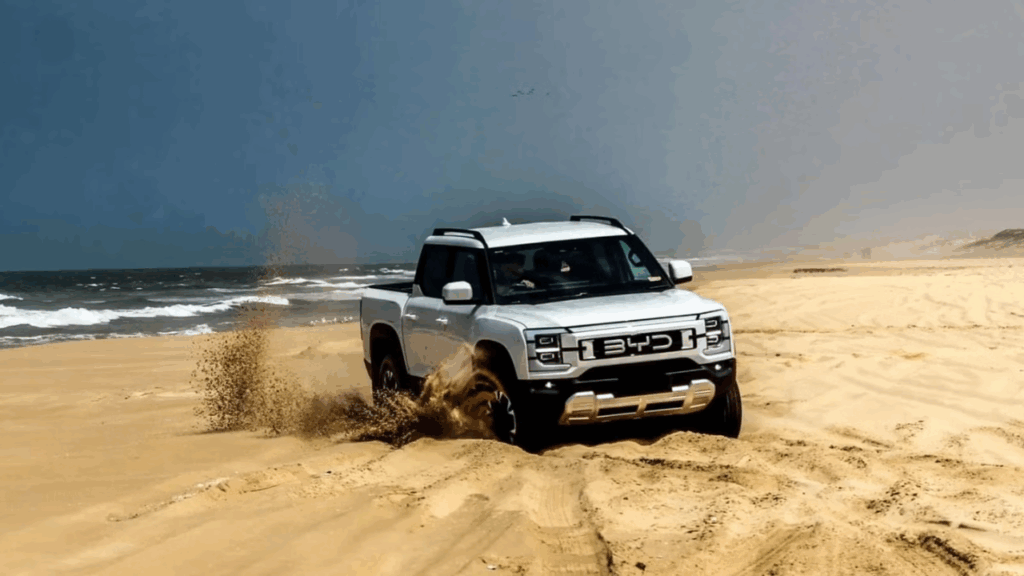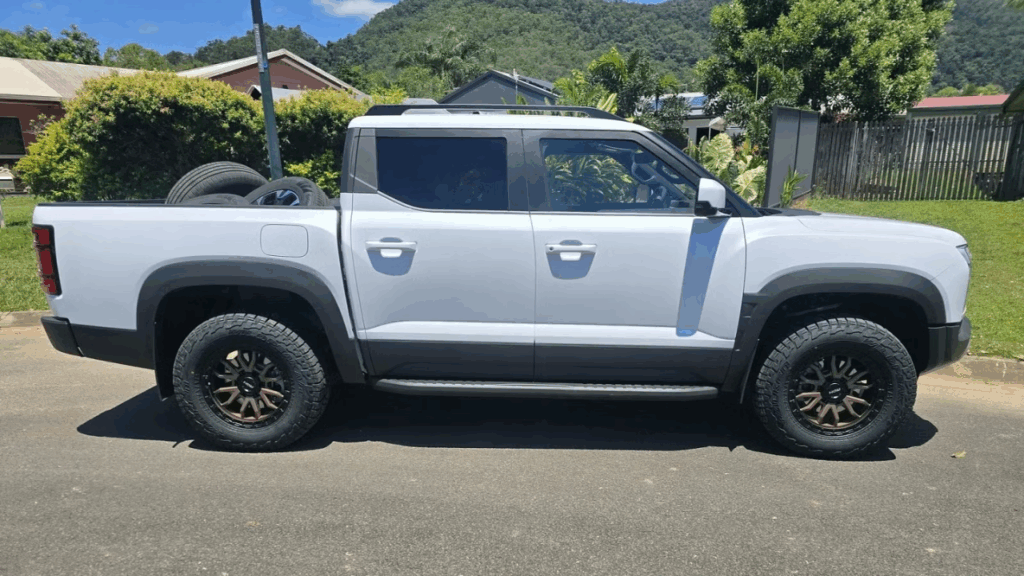The automotive landscape in Australia has shifted dramatically in 2025, with BYD’s Shark 6 emerging as the undisputed champion of the plug-in hybrid electric vehicle (PHEV) segment. This Chinese-built dual-cab ute has not only captured over a third of Australia’s PHEV market share but has also proven that electrified utes can compete head-to-head with traditional diesel workhorses.
Bottom Line Up Front: The BYD Shark 6 sold 4,836 units in Q1 2025, representing an impressive 35.3% of total PHEV sales in Australia, making it the country’s best-selling plug-in hybrid vehicle and third most popular ute overall.
The Numbers That Tell the Story

The first quarter of 2025 painted a remarkable picture for BYD’s breakthrough ute. With 13,698 PHEVs delivered across Australia in Q1 2025 and the Shark 6 accounting for 4,836 of those sales, BYD captured over a third of the market. This performance becomes even more impressive when you consider the broader context.
BYD as a brand accounted for 50% of all plug-in hybrids delivered in the first quarter, with the Shark 6 alone responsible for over a third of the PHEV market. The Chinese automaker sold almost twice as many examples of its ute than the next best-selling PHEV, proving that Australian buyers are ready to embrace electrified commercial vehicles.
March Madness: Peak Performance Month
March 2025 marked a pivotal moment for the Shark 6’s sales trajectory. The BYD Shark 6 spectacularly repeated at #6 with a record 2.5% share, proving that last month’s result was not a fluke, with 2,810 units sold in March alone. This performance placed it among Australia’s top-selling vehicles, regardless of fuel type.
The dual-cab phenomenon didn’t just dominate the PHEV space – it carved out significant territory in the highly competitive ute segment. The BYD Shark 6 claimed third position as Australia’s most popular ute, overtaking the Isuzu D-Max, a remarkable achievement for a brand that only entered the Australian market three years ago.
What Makes the Shark 6 Special?
Groundbreaking Powertrain Technology
The BYD Shark 6 isn’t just another ute with a battery bolted on. It features an AWD Plug-in hybrid architecture built from the ground up, delivering a combined range of 800km per tank while providing the capability to reach 100km/h in as little as 5.7 seconds. This represents a fundamental shift in how we think about commercial vehicle performance.
The hybrid drivetrain combines a 1.5-litre turbo petrol engine with dual electric motors. The system boasts a massive 321kW of power and groundbreaking 650Nm of torque maximum output, giving the BYD Shark 6 a 2,500kg braked towing capacity. While the towing capacity sits below traditional diesel utes, the immediate torque delivery and fuel efficiency gains make it compelling for many buyers.
Pricing That Disrupts the Market
Value proposition has been central to the Shark 6’s success story. Pricing for the BYD Shark 6 has been announced at $57,900 before on-road costs, undercutting the likes of the Ford Ranger XLT Bi-Turbo dual-cab ($63,640 before on-roads) and the Toyota HiLux SR5 with V-Active Technology ($63,260 before on-roads).
This aggressive pricing strategy positions the Shark 6 as a premium offering at a competitive price point. When you factor in the advanced technology, comprehensive warranty coverage, and fuel savings potential, the value equation becomes even more attractive for Australian buyers.
The Perfect Storm of Timing
Several factors aligned perfectly to create the ideal market conditions for the Shark 6’s success in Q1 2025. The removal of the Fringe Benefits Tax (FBT) exemption for PHEVs on April 1, 2025, created urgency among fleet buyers and salary packaging customers.
Sales have definitely been boosted by the upcoming end of the tax exemption on PHEVs. This tax incentive, estimated to deliver savings of up to $5,500 through novated leasing arrangements, prompted many buyers to act quickly before the deadline.
The timing advantage also came from being first to market. The Shark 6 is the first PHEV ute on sale in Australia, beating the Ford Ranger PHEV and GWM Cannon Alpha Hi-4T to market. This head start allowed BYD to establish market presence before competitors could respond.
Real-World Performance: Beyond the Marketing
Driving Experience Revolution
The on-road experience of the Shark 6 challenges traditional ute expectations. The absence of diesel clatter is a slightly surreal experience, and the near-silence isn’t interrupted by noisy tyres. The immediacy of the drivetrain’s response is also uncanny, making the Shark 6 an utterly effortless vehicle to drive despite a 2.7-tonne kerb weight.
Real-world testing has validated BYD’s performance claims. We could easily believe the claimed 0-100km/h acceleration time of 5.7 seconds, though we conducted our own testing all the same – and achieved the run in 5.6 seconds. This level of performance puts it ahead of many performance-focused diesel utes.
Technology and Features
The feature-rich interior sets new standards for commercial vehicles in this price range. Advanced features include a 15.6 inch intelligent rotating touch screen infotainment system (Premium model), a 10.25 inch digital instrument cluster, wireless phone charger, and Bluetooth connectivity with DAB digital radio and voice assistant.
Market Impact and Industry Response
Changing Consumer Preferences
The Shark 6’s success reflects broader shifts in Australian automotive preferences. PHEVs surged 346.1% to 4,871 with the help of BYD in February alone, demonstrating that consumers are increasingly open to electrified alternatives in traditionally conservative market segments.
This paradigm shift extends beyond individual buyers to fleet operators and businesses looking to reduce operating costs and emissions. The combination of electric driving capability for urban use and extended range for regional work makes PHEVs particularly attractive to commercial operators.
Competitive Landscape Heating Up
The market disruption caused by the Shark 6 hasn’t gone unnoticed by traditional manufacturers. The GWM Cannon Alpha PHEV is now up to $4,100 cheaper depending on where in Australia you live, provided you’re an ABN holder, showing how quickly competitors are responding to BYD’s pricing pressure.
Ford and other established brands are accelerating their electrification timelines partly in response to Chinese manufacturers’ success. The upcoming Ford Ranger PHEV and other models represent the industry’s recognition that electrified commercial vehicles are no longer a niche market.
Global Context: BYD’s Worldwide Success
Record-Breaking Quarter
The Australian success forms part of BYD’s remarkable global performance. BYD delivered 377,420 vehicles globally in March 2025, bringing their first-quarter total to over 1 million units, representing a 59.81% increase year-on-year. This worldwide momentum provides the scale and resources necessary to support aggressive expansion in markets like Australia.
BYD’s international growth strategy focuses on markets where traditional manufacturers haven’t fully committed to electrification. Australia represents a perfect example of this approach, where the company has established strong market presence while legacy brands were slower to introduce electrified commercial vehicles.
Challenges and Future Outlook
Infrastructure and Support Network
The rapid sales growth brings challenges around service infrastructure and parts supply. BYD has partnered with Ironman 4×4 for accessories and is expanding its dealer network, but maintaining service quality during rapid expansion remains critical for long-term success.
The BYD Shark 6 is covered by a six-year, 150,000km vehicle warranty and an eight-year, 160,000km high-voltage battery warranty. These extended warranties help build buyer confidence but require robust support infrastructure to deliver on promises.
Competition Intensification
The competitive landscape will intensify significantly through 2025. With Ford’s Ranger PHEV launching and other manufacturers bringing electrified utes to market, BYD’s first-mover advantage will face serious challenges. The company’s ability to maintain market share will depend on continued innovation and competitive pricing.
Electric vehicle adoption in Australia continues growing, but the end of FBT exemptions for PHEVs may slow growth in coming quarters. Removal of the FBT exemption will cause a significant downturn in the PHEV market, which grew a staggering 222% in February this year to date.
The Road Ahead: What This Means for Australian Drivers
Changing Ute Landscape
The Shark 6’s success signals a fundamental shift in Australian ute preferences. Buyers are increasingly willing to consider alternatives to traditional diesel powertrains, especially when those alternatives offer better performance, lower running costs, and advanced technology.
This market evolution will accelerate electrification across the commercial vehicle segment. Fleet operators, tradies, and recreational users are all discovering that electric and hybrid utes can meet their needs while offering significant advantages in urban environments.
Technology Adoption Acceleration

The mainstream acceptance of PHEV utes will drive broader adoption of electrified commercial vehicles. As charging infrastructure improves and battery technology advances, pure electric utes will likely follow the hybrid success story established by vehicles like the Shark 6.
Australian manufacturers and importers must adapt quickly to changing consumer preferences. The success of Chinese brands like BYD demonstrates that origin matters less than value, performance, and meeting customer needs.
A New Era for Australian Utes
The BYD Shark 6’s domination of Australia’s PHEV market in Q1 2025 represents more than just impressive sales figures. It signals the beginning of a new era where electrified commercial vehicles can successfully compete with traditional alternatives on performance, features, and value.
With over a third of the PHEV market captured in just its first few months, the Shark 6 has proven that Australian buyers are ready for change. The combination of advanced technology, competitive pricing, and strong performance has created a template that will likely influence the entire ute segment going forward.
The revolution is just beginning – and BYD has fired the first successful shot in what promises to be an exciting transformation of Australia’s commercial vehicle landscape.
Frequently Asked Questions
Q: How much does the BYD Shark 6 cost in Australia?
The BYD Shark 6 starts at $57,900 before on-road costs, making it competitively priced against traditional diesel utes.
Q: What’s the electric driving range of the Shark 6?
The Shark 6 offers 100km of pure electric driving range, with a total combined range of 800km per tank.
Q: How powerful is the BYD Shark 6?
The hybrid system produces 321kW of power and 650Nm of torque, with 0-100km/h acceleration in 5.7 seconds.
Q: What’s the towing capacity?
The Shark 6 can tow up to 2,500kg braked, which is lower than some diesel utes but adequate for most users.
Q: Is the BYD Shark 6 reliable?
BYD offers a six-year, 150,000km vehicle warranty and an eight-year, 160,000km battery warranty.
Q: Are there any competitors to the Shark 6?
The Ford Ranger PHEV and GWM Cannon Alpha PHEV are arriving in 2025 as direct competitors.

